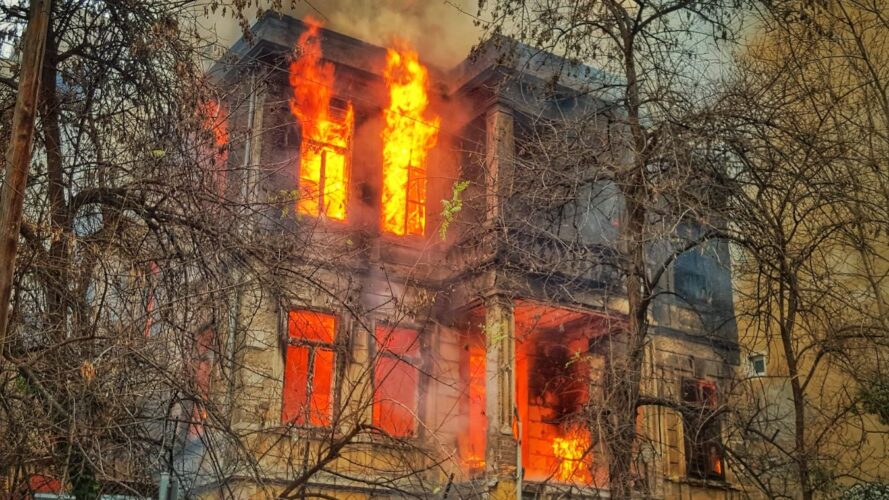New statistics reflect thousands of incidents of building fires each year, including many in commercial properties. Perhaps most surprisingly, almost 10% of all non-residential building fires are set deliberately – proving that however well you control fire risks on site, there is always the potential for a fire to occur regardless.
A range of factors mean that commercial properties are at greater risk of fires than at any point in recent history. While putting measures in place to control and eliminate fire risks is important, it’s equally important for businesses to have a plan in case a fire does happen – helping to both limit damage and respond in a way that could save lives.
Why fires are a growing threat
Fire safety is not the most obvious point on any health & safety checklists, particularly in businesses which do not have obvious fire risks. Offices, warehouses and other environments that do not have obvious ignition sources can often push fire safety to one side, investing in fire extinguishers or sprinkler systems, but not instilling a culture of fire safety. This belies not only the real risks of these environments, but the factors that are making fires in the workplace more likely.
One obvious factor in the rising incidence of fires in commercial buildings is climate change. As the UK and much of Europe has experienced this year, average temperatures are rising, as is the prevalence of extreme temperatures. Hotter temperatures not only raises the risks for combustible and explosive materials, such as gas canisters, but the chance of other materials igniting. Wood, paper, and detritus around buildings can become extremely dry and prone to igniting under high temperatures.
Another factor is the falling occupancy of buildings. The trend towards remote working means that many sites have fewer people working at any given time than previously. This could directly affect fire safety in terms of having fewer or no fire marshals or other responsible persons on-site, but it also means that there are fewer people to spot and address fire risks, or to respond quickly in the event of a fire. This is something that many businesses may not have considered during the tumultuous return to workplaces after the pandemic.
The importance of fire risk assessments
The most obvious step – and a pillar of any workplace’s health and safety policy – is to have a distinct fire safety policy. This should be subject to a detailed fire risk assessment, carried out on a regular basis. While there is no strict definition of what ‘regular’ means – it will vary depending on the risk factors in your business – once a year is generally advisable, or whenever there are significant changes to the workplace or personnel.
Fire safety assessments must be conducted by a qualified fire safety assessor. It’s fairly common for businesses to provide fire safety assessor training to one or more responsible persons (e.g. fire marshals), who are responsible for both spotting and addressing fire risks, and responding appropriately in the event of a fire. SAMS can provide fire safety assessor training in both our dedicated video course and the Level 1 in Fire Safety course.
A fire safety policy should also outline the response of employees in the event of a fire. This will chiefly concern things like the meeting point and who has responsibility for directing the evacuation effort, as well as procedures for contacting the emergency services. However,
it may also detail things like escape routes and the situations in employees which it may be appropriate to fight the fire with available fire safety equipment.
How employees can prevent fires at work
While a fire safety policy is crucial, it is relatively meaningless if the principles within it aren’t applied. Actions speak louder than words, as do people’s attitudes to safety. An effective approach to fire safety is one that instils a fire safety culture in the workplace: one where take fire safety seriously, are aware of the risks, and are empowered to speak up when they see something that could be dangerous, so that it can be quickly addressed.
The first thing is to make employees feel that they can report safety hazards of all kinds, but particularly fire hazards. If someone sees something blocking a fire exit, for instance, they shouldn’t feel that they will be disparaged for pointing it out. Safety should be something that everyone reinforces and helps out with, without blaming anyone else. Equally, lessons should be learned from honest mistakes, so that they aren’t repeated.
Secondly, employees should ideally receive a basic level of fire safety awareness training. This will help them to more keenly appreciate why fires pose such a threat to life, and what the basic steps are to protect against them. Reiterating the value of reducing clutter, careful handling of ignition sources, keeping fire exits closed and knowing your evacuation plan will all help people to act correctly, both in fire prevention and fire emergency response.
As an employee, if you feel any of these provisions are not being made, and fire safety is being compromised, you should not feel compelled to continue working in an unsafe environment. Employers have a legal responsibility to ensure the safety and wellbeing of their employees, and any incidents or ‘near misses’ should be reported to the HSE. If they aren’t, you have a right to approach your trade union representative, or to escalate the matter to the HSE yourself.
Fire safety is a more pressing issue than ever before, and is likely to become more critical as temperatures and extreme weather events increase. Acting now to train employees, reform your fire safety policies, and invest in fire protection will help you to keep ahead of the curve – avoiding costly and devastating losses that could imperil your employees and your business.

